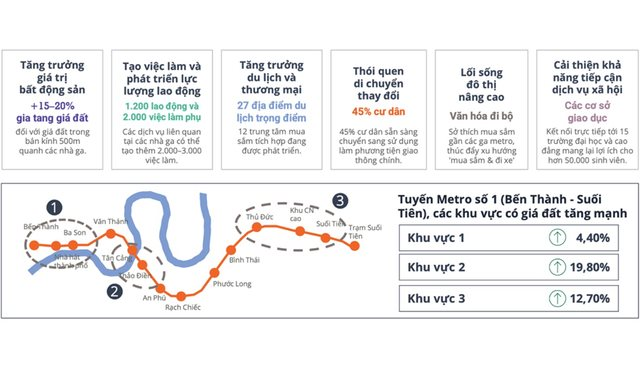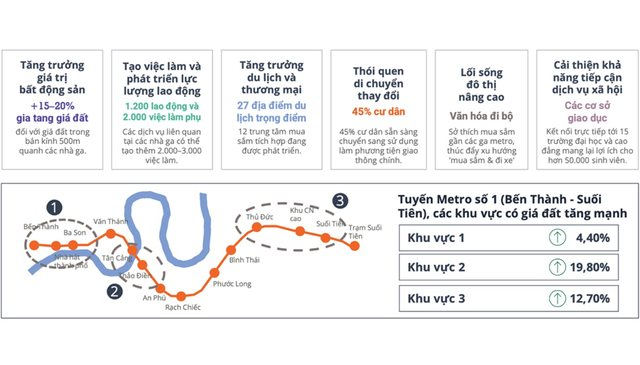Forging Ahead with Metro Development
Recent news about the acceleration of survey work and data collection for the pre-feasibility study report of the elevated urban railway line number 2 (Binh Duong metro line 2) has caught the market’s attention. Binh Duong’s priority investment in this metro line has positively impacted home buyers’ dynamics.
Binh Duong Metro Line 2 is planned to be over 23km long, connecting the center of Thu Dau Mot City to Binh Phuoc Junction in Ho Chi Minh City, running along National Highway 13 and connecting to the future Hiệp Bình Phước Station (Ho Chi Minh City’s metro line 3B). This connection aims to reduce traffic congestion on critical routes such as National Highway 13 and Pham Van Dong Street.
National Highway 13 is a vital artery linking the center of Ho Chi Minh City with the cities of Binh Duong. Ho Chi Minh City has recently approved the investment to expand this highway (from Binh Trieu Bridge to the border of Binh Duong province) to 60 meters, accommodating ten lanes. The project is expected to commence in Q2 2026 and be completed by 2028. Once finished, National Highway 13 will alleviate the bottleneck at the northeastern gateway to Ho Chi Minh City.
National Highway 13 and Binh Duong Metro Line 2 will be a pivotal infrastructure duo, contributing to reduced traffic congestion and enhanced connectivity between Ho Chi Minh City and Binh Duong. They will promote economic and social development and positively impact the real estate market. These two critical infrastructure projects are expected to become growth drivers for the real estate market in the northeastern part of Ho Chi Minh City.
Surveys indicate that several apartment projects along National Highway 13 are already in the market or under development. These projects are anticipated to benefit directly from the infrastructure investments, and their future price appreciation is evident. Examples include La Pura, The Rivana, The Habitat, Canary Heights, and Vạn Phúc City.
Mr. Dinh Minh Tuan, Southern Region Director of Batdongsan.com.vn, analyzed that developing Binh Duong’s metro lines would not only help solve urban transportation issues but also create sustainable growth momentum for the real estate market.
Practical evidence from Ho Chi Minh City’s Metro Line 1 shows that areas within a 500-800m radius of the stations experienced price increases of 10-15% immediately before and after the line became operational. It also attracted high-end real estate projects, forming transit-oriented communities with high population density and a comprehensive ecosystem of amenities. “This will be an inevitable trend in the process of urban restructuring, enhancing the value of real estate associated with public transport in the medium and long term,” emphasized Mr. Tuan.
Data from Avison Young also highlights the economic, social, and real estate impacts of metro development. The representative of Avison Young cited the example of Ho Chi Minh City’s Metro Line 1 (Ben Thanh – Suoi Tien), which significantly transformed the city’s landscape and alleviated traffic congestion, reducing travel time.

Metro lines play a crucial role in promoting urbanization along their routes – Source: Avison Young’s market report for April 2025
Avison Young’s experts believe that developing metro lines following the TOD model sustainably enhances real estate value. Synchronized transportation infrastructure investments, improved connectivity, and reduced travel time will attract residents and boost housing demand and commercial activities.
Metro Line 1 is the most prominent example. Its operation has significantly stimulated housing demand and commercial activities in the surrounding areas. In addition to new buyers, many individual investors have also realized profits by selling their assets after the metro line became operational. Most of these investors had held their properties for a long time, and their profits were multiple times their initial investment.
According to surveys, the average selling price in some projects near Metro Line 1 has increased by 50-70%, with some projects even reaching a 150% increase over eight years (2015-2023). This price appreciation is expected to occur similarly in Binh Duong as Metro Lines 1 and 2 are accelerated in the region. Looking at the price movements in Ho Chi Minh City’s real estate market near Metro Line 1 supports this expectation.
“Twin Waves” from the Merger Plan
In addition to infrastructure, Binh Duong’s upcoming merger with Ho Chi Minh City is creating a boost for the real estate market in the region.
DKRA Consulting’s report for the first quarter of the year showed a 56% increase in southern residential market demand compared to the same period last year. Before the merger announcement, Binh Duong’s primary apartment sales volume surpassed that of Ho Chi Minh City, accounting for 43.6% in Q1/2025.
The merger proposal is being urgently finalized. According to the plan, the resolution will take effect from September 1st, and the new Ho Chi Minh City will commence operations on September 15th. In a recent sharing, Ms. Giang Huynh, Director of Research at Savills Ho Chi Minh City, stated that after the merger, the new administrative unit will still be named Ho Chi Minh City and will become a super-city in the Southeast region. The merger will create a new economic and urban center with strong competitiveness, maximizing the natural advantages, geography, and infrastructure of the three localities.
She believes that the adjacent locations and well-connected transportation system between the three localities will facilitate more efficient urban and economic space planning. The expanded land area will provide opportunities for population dispersal strategies, the development of satellite cities, and the construction of modern new urban areas. Additionally, transportation infrastructure is expected to be standardized, particularly road, waterway, and seaport systems, enhancing regional connectivity and improving logistics capabilities.
“The expanded planning area after the merger will provide more flexibility for new planning decisions, shaping future infrastructure and residential areas. This will help address population dispersal and unlock new housing supply,” emphasized Ms. Giang Huynh.

Savills data reveals that Ho Chi Minh City’s apartment supply remains scarce, with a 70% decrease compared to the previous year. The most concerning aspect is the decline in affordable apartments (priced at around VND 50 million per square meter) in Ho Chi Minh City, accounting for only 13% of the total market supply. As a result, areas adjacent to the city center, such as the northeastern part of Ho Chi Minh City, have a competitive edge. With the merger, real estate prices in these areas are expected to surge.
Sharing this view, Mr. Vo Huynh Tuan Kiet, Director of Residential CBRE Vietnam, affirmed that the merger of the three provinces would significantly impact the real estate landscape. The potential opportunities for investors are immense. The merger is not just about the name but also entails significant changes in planning and overall strategies to interconnect the three regions, creating long-term value and shaping new demand and price levels.
Mr. Kiet pointed out that not all areas or projects would benefit from the merger announcement. Real estate price increases do not necessarily reflect sustainable socio-economic development in every region. Currently, only projects located near Ho Chi Minh City and along key transportation infrastructure routes under development are likely to experience growth in value. There are still opportunities for buyers who enter the market early.
Indeed, even before the merger with Ho Chi Minh City, Binh Duong’s real estate market was already robust, supported by a “triple foundation”: economy, infrastructure, and urban population attraction. The price increases and real estate transactions in the region are not solely driven by the psychological factor of the merger but also by a solid foundation built over a long period. Additionally, Binh Duong currently offers the highest rental yields in the country, surpassing major cities like Ho Chi Minh City and Hanoi by around 30%.
These “silent waves” in the region indicate that buyers have recognized the value appreciation potential in a market underpinned by multiple sustainable growth drivers.
The Big Apple Takes a Bite Out of Red Tape: Streamlining Construction with a Pilot Study
“The talented and esteemed Chairman of the People’s Committee of Ho Chi Minh City, Nguyen Van Duoc, has entrusted the Department of Construction with an innovative task. He has directed the department to explore a pilot program that would forgo the need for construction permits in areas with detailed planning or established road boundaries. This forward-thinking approach aims to streamline the construction process and promote efficient urban development in the vibrant city.”
The New Move Unveils the Future of the “Super Port” in Can Gio
The “Super Port” Can Gio project is taking a significant step forward with the People’s Committee of Ho Chi Minh City submitting a proposal to the Party Committee and the People’s Committee of the city regarding the development of this ambitious initiative.
Unlocking Regional Economic Potential: The Golden Opportunity for Profitable and Sustainable Real Estate Investments
From West West Lake to South of the Red River, Hanoi is witnessing a strategic transformation: infrastructure acceleration and regional economic take-off. In this shift, real estate emerges as the preferred investment channel, not only for its prime location but also for the strong backing of planning and public investment.





















